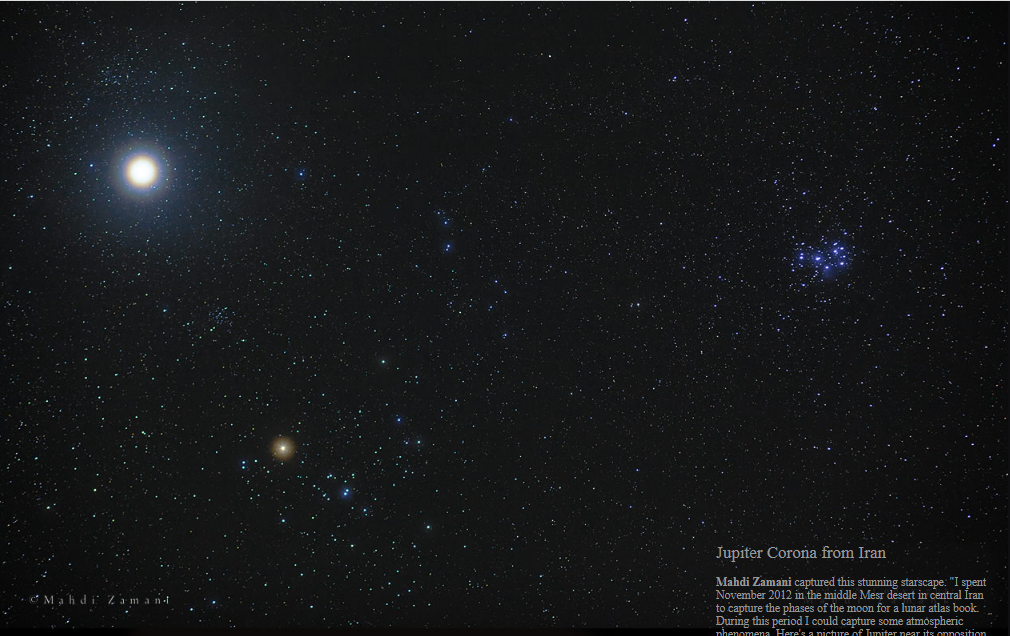OPOD - Jupiter Corona
OPOD - Jupiter Corona: A Phenomenon in the Night Sky
Have you ever looked up at the night sky and been captivated by the beauty of the stars? Well, there is more to the celestial wonders than meets the eye. One such phenomenon is the Jupiter Corona, a stunning display that can be observed in certain atmospheric conditions. In this article, we will delve deeper into the intricacies of this captivating optical phenomenon.
Capturing the Jupiter Corona
The Jupiter Corona is not an everyday occurrence, and capturing it on camera requires both skill and favorable conditions. Long exposures and steady cloud or haze conditions are necessary to capture the rings surrounding Jupiter. Photographers like Mahdi Zamani have managed to capture this phenomenon, showcasing its ethereal beauty.
The Science Behind the Rings
The formation of the Jupiter Corona is attributed to the scattering of light by small water droplets in the atmosphere. These droplets, regardless of their size, create a ringed corona around celestial bodies such as the sun, moon, Venus, Jupiter, and even stars. The periphery of these droplets plays a crucial role in scattering light, resulting in the coronal diffraction pattern.
Unusual Sightings
While aureoles around Jupiter and Venus have become increasingly common in photographs, a ringed corona remains relatively rare. This phenomenon suggests that water droplets of nearly uniform size are diffracting the rays emitted by Jupiter. The orange giant star, Aldebaran, also exhibits an aureole, and with longer exposures, it may be possible to capture a coronal ring around it as well.
Beyond Earth's Atmosphere
Interestingly, not all coronas are formed within our atmosphere. The blue-violet nebulosity surrounding the Pleiades, for example, is not a result of atmospheric conditions. Instead, it is caused by the intense light emitted by very hot cluster stars, which is scattered by the surrounding dust. If this dust were of uniform size and shape, we might witness a corona in this extraterrestrial environment.
The Magic of Atmospheric Optics
Atmospheric optics is a field that continues to amaze us with its countless phenomena. The Jupiter Corona is just one example of the mesmerizing displays that can be observed in the night sky. It serves as a reminder of the intricate interplay between light, water droplets, and the atmosphere, creating breathtaking sights for those fortunate enough to witness them.
A Universe of Possibilities
As we explore the vast expanse of the universe, it is only a matter of time before we encounter similar coronas in other celestial bodies. Somewhere out there, in the depths of space, conditions may align, and we may witness the formation of coronal rings around distant stars or planets. The universe holds countless mysteries, and the occurrence of coronas beyond our atmosphere is just one of them.
In conclusion, the Jupiter Corona is a captivating optical phenomenon that occurs when light is scattered by small water droplets in our atmosphere. Its unique rings surrounding celestial bodies like Jupiter are a rare sight to behold. As we continue to unravel the mysteries of atmospheric optics, we may discover similar coronas in other parts of the universe. The beauty and complexity of these phenomena serve as a reminder of the wonders that await us in the night sky. So, next time you gaze up at the stars, remember that there is always more than meets the eye.

Jupiter Corona from Iran
Mahdi Zamani captured this stunning starscape. "I spent November 2012 in the middle Mesr desert in central Iran to capture the phases of the moon for a lunar atlas book. During this period I could capture some atmospheric phenomena. Here's a picture of Jupiter near its opposition surrounded by a corona."
©Mahdi Zamani, shown with permission.
Small water droplets are no respecters of light sources. They will form a ringed corona around the sun, the moon, Venus, Jupiter and all the stars. Long exposures and steady cloud/haze conditions would be needed to capture the rings of the latter.
Light is scattered mainly by the periphery of the droplets. The individual outgoing spherical wave trains combine constructively or destructively to give the coronal diffraction pattern

Aureoles around Jupiter and Venus are increasingly photographed but a ringed corona is unusual. It speaks of water droplets of almost all the same size diffracting the Jovian rays,
The orange giant star, Aldebaran, has an aureole and longer exposures could possibly reveal a coronal ring.
The blue-violet nebulosity around the Pleiades is not of our atmosphere. It is the harsh light of very hot cluster stars scattered by surrounding dust If the dust was of uniform size and shape we might see a corona. Somewhere in the Universe that will happen.
Note: this article has been automatically converted from the old site and may not appear as intended. You can find the original article here.
Reference Atmospheric Optics
If you use any of the definitions, information, or data presented on Atmospheric Optics, please copy the link or reference below to properly credit us as the reference source. Thank you!
-
<a href="https://atoptics.co.uk/blog/opod-jupiter-corona/">OPOD - Jupiter Corona</a>
-
"OPOD - Jupiter Corona". Atmospheric Optics. Accessed on December 23, 2024. https://atoptics.co.uk/blog/opod-jupiter-corona/.
-
"OPOD - Jupiter Corona". Atmospheric Optics, https://atoptics.co.uk/blog/opod-jupiter-corona/. Accessed 23 December, 2024
-
OPOD - Jupiter Corona. Atmospheric Optics. Retrieved from https://atoptics.co.uk/blog/opod-jupiter-corona/.